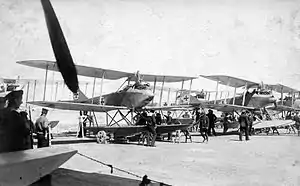| 6B | |
|---|---|
 | |
| Rumpler 6B1 | |
| Role | Floatplane fighter |
| Manufacturer | Rumpler Flugzeugwerke |
| First flight | 1916 |
| Introduction | 1916 |
| Retired | 1920s |
| Primary users | German Imperial Navy Finnish Air Force |
| Produced | 1916–1918 |
| Number built | 88 |
| Developed from | Rumpler C.I |
The Rumpler 6B was a German single-engine floatplane fighter with a biplane wing structure, designed and built by Rumpler Flugzeugwerke, in Berlin Johannisthal and introduced in 1916.
Design and development
Born out of a requirement of the Kaiserliche Marine (Imperial Navy) for a seaplane fighter, the Rumpler 6B was, like its contemporaries the Albatros W.4 and Hansa-Brandenburg W.9, an adaptation of an existing landplane design. In Rumpler's case, the new floatplane fighter was based on the company's two-seat C.I reconnaissance aircraft. The modifications included adding a forward stagger to the wings, removal of the second (observer's) cockpit and fitting a larger rudder to offset the increased side area caused by the addition of floats. In the production aircraft, the area of the horizontal tail surfaces was also slightly reduced. The armament consisted of a fixed, forward-firing 7.92 mm (.312 in) LMG 08/15 "Spandau" machine gun mounted on port side of the engine block.
The initial version of the fighter was the 6B1. A total of 39 of these were produced, with all but one of the number having been delivered by the end of May 1917. A new version of the basic design, the 6B2, was introduced in October 1917. These aircraft retained the Mercedes D.III engine, but otherwise they were based on the C.IV, with larger dimensions and more rounded horizontal tail surfaces. In spite of the decrease in performance, 49 of this type were delivered between October 1917 and January 1918, during which time the remaining 6B1 also left the factory.
Operational history
The Rumpler 6Bs were mostly employed at German seaplane bases at Ostend and Zeebrugge. Some were also sent to the Black Sea area to fight the Russians.
Use in Bulgaria
The two 6B1 naval fighters stationed at the German Naval Air Station Peynerdjik near Varna on the Black Sea were transferred in June 1918 to the Bulgarian Navy. They were used after the war in minesweeping operations. In 1920, they were destroyed in accordance with the clauses of the Peace Treaty.[1]
Use in Finland
In February 1918, the Finnish White Army ordered one Rumpler and seven other aircraft from Germany. The aircraft was destroyed in an accident in October 1919. Another Rumpler aircraft was bought from the Germans in Tallinn in 1918 and it was used for seven years.
Survivors
Hallinportti Aviation Museum has one Rumpler in storage.
Operators
Specifications (6B1)

Data from Fighters : attack and training aircraft 1914-19,[2] The Rand McNally Encyclopedia of Military Aircraft, 1914–1980[3]
General characteristics
- Crew: 1
- Length: 9.4 m (30 ft 10 in)
- Wingspan: 12.05 m (39 ft 6 in)
- Height: 3.5 m (11 ft 6 in)
- Wing area: 38 m2 (410 sq ft)
- Max takeoff weight: 1,140 kg (2,513 lb)
- Powerplant: 1 × Mercedes D.III 6-cylinder water-cooled in-line piston engine, 120 kW (160 hp)
- Propellers: 2-bladed fixed-pitch propeller
Performance
- Maximum speed: 153 km/h (95 mph, 83 kn)
- Endurance: 4 hours
- Service ceiling: 5,000 m (16,000 ft)
Armament
- Guns: 1 × fixed, forward-firing 7.92 mm (.312 in) LMG 08/15 with an interruptor gear
See also
Aircraft of comparable role, configuration, and era
Related lists
References
- ↑ Milanov, Y. The Aviation in Bulgaria in the Wars from 1912 to 1945, Vol. I(in Bulgarian). Sveti Gueorgui Pobedonosetz, Sofia, 1995.
- ↑ Munson, Kenneth. Fighters : attack and training aircraft 1914-19. London: Bounty Books. ISBN 0-7537-0916-3.
- ↑ Angelucci, Enzo (1983). The Rand McNally encyclopedia of military aircraft, 1914-1980. San Diego, California: The Military Press. ISBN 0-517-41021-4.
Further reading
- Herris, Jack (2012). German Seaplane Fighters of WWI: A Centennial Perspective on Great War Seaplanes. Great War Aviation Centennial Series. Vol. 2. Charleston (S.C.): Aeronaut Books. ISBN 978-1-935881-09-4.
- Herris, Jack (2014). Rumpler Aircraft of WWI: A Centennial Perspective on Great War Airplanes. Great War Aviation Centennial Series. Vol. 11. n.p.: Aeronaut Books. ISBN 978-1-935881-21-6.
- Keskinen, Kalevi; Stenman, Kari; Niska, Klaus (1976). Suomen ilmavoimien lentokoneet 1918–1939 (in Finnish). Helsinki: Tietoteos.
- Keskinen, Kalevi; Partonen, Kyösti; Stenman, Kari (2005). Suomen ilmavoimat 1918-1927 (in Finnish). Helsinki: Kustannusliike Kari Stenman. ISBN 952-99432-2-9.</ref>
- Nicolle, David (March–April 1999). "Young Turks: Ottoman Turkish Fighters 1915–1918". Air Enthusiast. No. 74. pp. 40–45. ISSN 0143-5450.